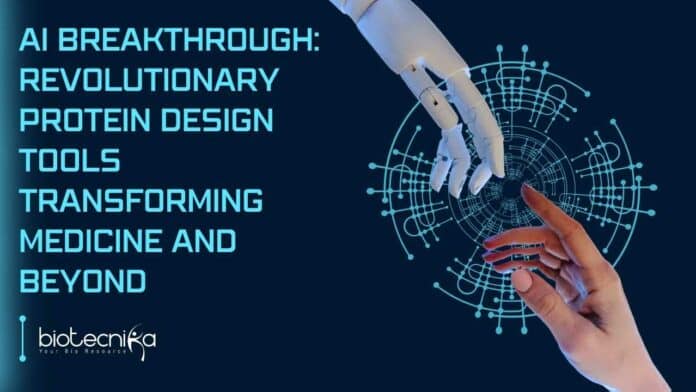AI Breakthrough: Revolutionary Protein Design Tools Transforming Medicine and Beyond
Cutting-edge AI technology creates custom proteins with game-changing potential for therapeutics, vaccines, and biomaterials.
In a groundbreaking development, researchers at the University of Washington have harnessed the power of artificial intelligence (AI) to design entirely new proteins. These AI tools, such as RFdiffusion, have the potential to revolutionize medicine by creating custom proteins that can be used in therapeutics, vaccines, and biomaterials. Inspired by AI software used in digital art, these tools have unlocked the ability to generate realistic protein shapes according to specific design criteria, marking a transformative moment in the field of protein design.
The Challenge of Protein Design:
Designing new proteins has historically been a challenging and often unsuccessful process. Scientists relied on intuition, trial and error, and limited understanding of protein folding and function. Previous attempts involved piecing together fragments of existing proteins, hoping to create a useful structure. However, this approach was time-consuming and inefficient, requiring extensive screening and testing of thousands of designs.
The Rise of AI in Protein Design:
The breakthrough in protein design came with the advent of AI-based models, such as AlphaFold developed by DeepMind. These models accurately predict protein structures from amino acid sequences, offering insights into the folding and functioning of proteins. Building upon this foundation, AI tools for protein design emerged. Researchers, including those at the University of Washington, developed tools like RFdiffusion, which leverages neural networks to generate new protein structures.
How AI Protein Design Works:
AI protein design tools like RFdiffusion are trained on vast datasets of real protein structures stored in repositories like the Protein Data Bank. The design process begins with random noise, representing a jumble of amino acids. The neural network progressively refines this noise, ultimately generating a new protein structure that closely resembles a real protein.
Researchers can also condition the AI tool to meet specific design constraints during the protein generation process. For instance, they can instruct the tool to create proteins with specific folds or proteins that can interact and bind tightly to other biomolecules. This conditioning ability empowers scientists to tailor the AI tool’s output to meet their specific requirements.
The Transformative Potential of AI Protein Design: The advent of AI-based protein design tools has revolutionized the field. These tools enable scientists to create proteins with sought-after qualities and functions that were previously unattainable. Early experiments have demonstrated promising results, with a significantly higher success rate compared to previous methods. Proteins designed by AI tools like RFdiffusion have shown strong binding capabilities to proteins associated with cancer, autoimmune diseases, and other conditions.
Applications in Medicine and Beyond: The applications of AI-designed proteins are vast. They can serve as the foundation for novel therapeutics, vaccines, and biomaterials. Researchers have successfully created proteins that self-assemble into complex nanoparticles capable of delivering drugs or vaccine components. AI tools like RFdiffusion have proven adept at designing proteins that bind strongly to proteins implicated in various diseases, expanding the possibilities for targeted therapies.
Challenges and Future Directions: While the current AI protein design tools have shown remarkable capabilities, challenges remain. Designing more complex binding proteins, such as antibodies, presents a significant hurdle. Proteins with flexible regions that can adopt various shapes pose additional challenges for AI modeling. Researchers are actively exploring methods to overcome these obstacles and expand the capabilities of AI-based protein design tools.
Future improvements may involve training AI systems on a wider range of protein structures, enabling the creation of proteins that diverge from existing natural structures. Additionally, researchers are exploring the potential of generating proteins based on plain language descriptions, further simplifying the design process.
AI-based protein design tools like RFdiffusion have ushered in a new era of possibilities in medicine and biomaterials. The ability to create custom proteins with desired functions has the potential to transform the development of therapeutics, vaccines, and biomaterials. The success rates of these AI tools in generating functional proteins far surpass traditional methods, marking a significant milestone in the field of protein design. With continued research and advancements, AI protein design holds the promise of unlocking innovative solutions to address complex challenges in healthcare and beyond.
AI Breakthrough: Revolutionary Protein Design Tools Transforming Medicine and Beyond























